Blog

2014 Economy and Housing: From Deep Hole to Whimper
Referring to its “roller-coaster</bpattern of economic growth," Fannie Mae summarized the economy and housing inrn2014 as a year that started with a deep hole and ended with a whimper. A brutally cold first quarter put economicrngrowth in that deep hole at the beginning but it came back "with a vengeance"rnmaking the second quarter the strongest for growth in more than two years. The third quarter saw growth flag again andrnit "is poised tornweaken further, as some unsustainable forces that drove activity in the third quarterrnreverse in the final quarter."</p
Fannie Mae’s Macroeconomic ForecastingrnTeam headed by Senior Vice President and Chief Economist Doug Duncan reprisern2014 in the December edition of its Economic and Strategic Researchrnreport. They see the year overall as onernin which economic growth comes in at what they call an unspectacular pace ofrn2.1 percent, 1 percentage point below the 2013 pace. Next year however will be better, driven by improvingrnprivate domestic demand, a better outlook for consumer income, rising consumerrnand business confidence, a broadening housing recovery and they expect fullrnyear 2015 growth of 2.7 percent. </p
The rising trend of the “quits rate,” arnkey indicator of labor market confidence from the Job Openings and LaborrnTurnover Survey (JOLTS) supports, the Team says, its view that wage gains arernpoised to accelerate. Private wages inrnthe Employment Cost Index tend to lag the quits rate. Such improving incomernprospects they say are key to increasing the sub-par rate of housing formation butrnthe full recovery of the housing sector will require truly meaningful gains inrnthat income. </p
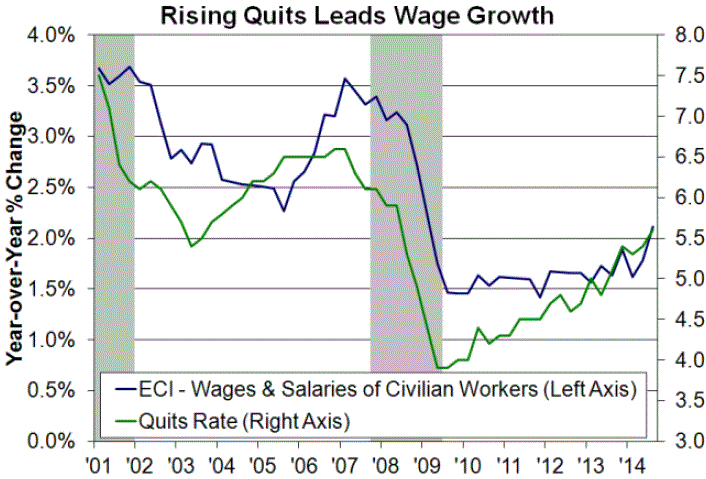 </p
</p
This year has been a disappointing one forrnhousing recovery. Improvement wasrntentative, especially for the single-family sector which was held back first byrnthe aforementioned severe winter weather and then by a spike in mortgagernrates. While rates have stabilized, demand remainsrnlow as homebuyers have not yet moved aggressively into the void left by exitingrninvestors.</p
Recent indicators, the economists say,rnhave been generally positive; existing home sales were up in both September andrnOctober, increasing to the highest levels since the previous fall, andrninventories reached their lowest levels since March. New home sales, however, improved little inrnthe last half of the year. </p
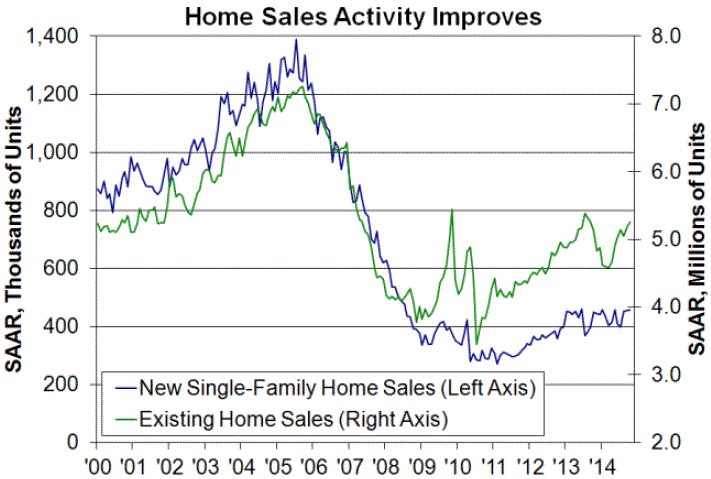 </p
</p
Nonetheless the National Association ofrnHome Builders’ measure of builder confidence rebounded sharply in Novemberrnalthough building itself has been mixed all year. Multifamily building starts have been thernstrongest since 2006 and are expected to post double-digit gains for the fourthrnstraight year while single family permits and starts have been much more modestrnwith starts up only 10 percent from last year. rnAll residential construction starts are expected to come in below onernmillion units which the economists called “anemic” by historical standards. </p
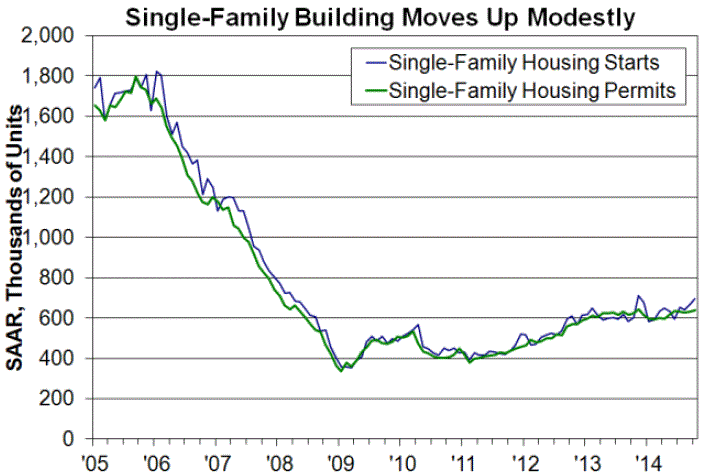 </p
</p
Most of the major indexes continue to showrnprice growth moderating. Still tightrninventories continue to support healthy price gains even in the face of softrnhomebuyer demand.</p
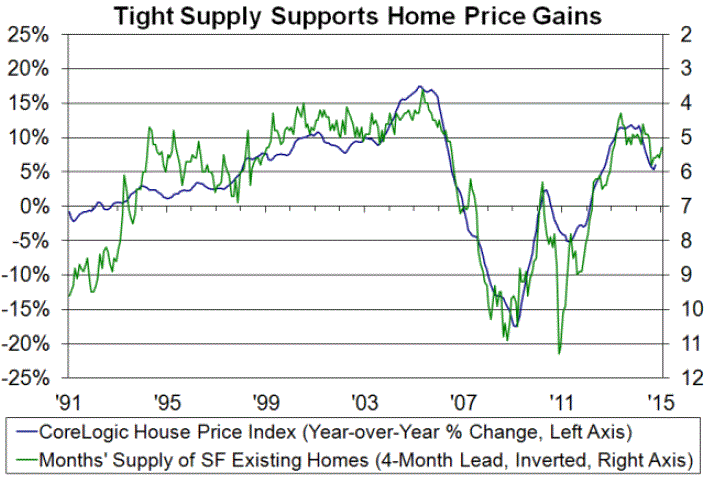 </p
</p
The Team says it expects 2015 will bring “arnbroad-based but measured housing recovery amid improving consumer sentiment andrnincome growth, slowly easing lending standards, and continued historically low mortgagernrates.” Long term Treasury yield will remainrndepressed because of soft spots in several of the globe’s economies and theyrnexpect that, as the Federal Reserve begins to raise short-term interest ratesrnin the third quarter of 2015, the yield curve will flatten further. Fixed mortgage interest rates are expected tornstay below 4.5 percent through 2015, continuing to support the housing market. </p
Fannie Mae projects housing starts willrnincrease about 22 percent and total home sales will grow about by about 5rnpercent after finishing 2014 down 3 percent. rnApplications for refinancing, according to the Mortgage BankersrnAssociation, have plummeted, “setting the stage for a purchase market in 2015.”</p
Total mortgage applications are expected tornedge up next year, after falling almost 40 percent this year. Fannie Mae projects originations to totalrn$1.13 trillion reflecting an increase in purchasing that will slightly morernthan offset an expected decline in refinancing of 37 percent. This drop will be in addition to an expectedrndecrease of 40 percent in refinancing in 2014 and 60 percent in 2013. Total single-family (1- to 4-unit properties)rnmortgage debt outstanding should post a slight decline in 2014 before pickingrnup modestly in coming years.</p
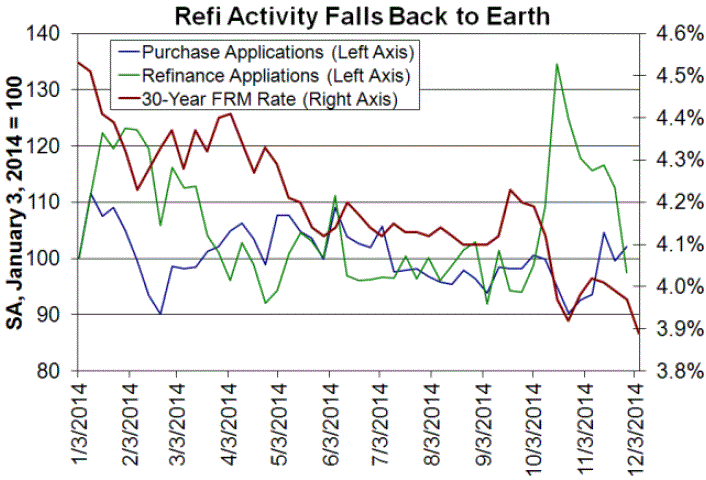
All Content Copyright © 2003 – 2009 Brown House Media, Inc. All Rights Reserved.nReproduction in any form without permission of MortgageNewsDaily.com is prohibited.
Latest Articles
By John Gittelsohn August 24, 2020, 4:00 AM PDT Some of the largest real estate investors are walking away from Read More...
Late-Stage Delinquencies are SurgingAug 21 2020, 11:59AM Like the report from Black Knight earlier today, the second quarter National Delinquency Survey from the Read More...
Published by the Federal Reserve Bank of San FranciscoIt was recently published by the Federal Reserve Bank of San Francisco, which is about as official as you can Read More...

Comments
Leave a Comment